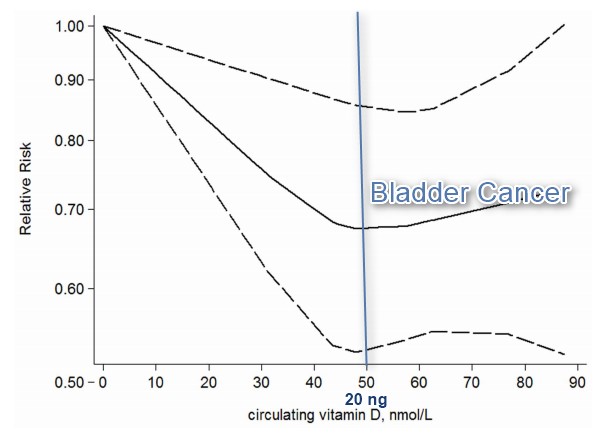Bladder Cancer deaths – 2.9X more likely if low Vitamin D, no death if more than 30 ng
Low Plasma 25-Hydoxyvitamin D at Diagnosis Predicts Poor Outcomes in Patients with Bladder Cancer: A Prospective Cohort Study
Nutr Cancer. 2020 Jul 16;1-7. doi: 10.1080/01635581.2020.1737150
Mohamed Kacem Ben Fradj 1 2, Mokhtar Bibi 1 3, Mohamed Bassem Hammami 1 2, Amani Kallel 1 2, Yassine Nouira 1 3, Moncef Feki 1 2

📄 Download the PDF from sci-hub VitaminDWiki
This study aimed to investigate whether plasma 25-hydroxyvitamin D (25-OHD) at diagnosis predicts poor outcomes in patients with urothelial bladder cancer. A total of 177 patients with non-muscle-invasive bladder cancer (NMIBC) were prospectively followed up over a period extending beyond 6 years. Data on poor outcomes (ie., recurrence, progression, and mortality) were collected. Plasma 25-OHD was measured by immunoassay. Cutoff-Finder web application was used to determine the best 25-OHD cutoff point to predict a specific poor outcome. Cox-hazard models were applied to test how plasma 25-OHD affect patients outcome while adjusting for potential confounding factors.
During the follow-up period,
tumor recurrence 40.7% of patients
tumor progression 14.1% of patients
and 11.3% of patients died.
Baseline 25-OHD was lower in patients who experienced poor outcome (12.2 ± 7.44 vs. 16.7 ± 10.6 ng/mL; p < 0.001).
Multi-adjusted HR (95% CI) for vitamin D deficiency (25-OHD < 12 ng/mL) was
2.09 (1.27-3.44) for recurrence
2.63 (1.06-6.49) for progression and
2.93 (1.04-8.25) for mortality in patients with NMIBC.
Low plasma 25-OHD in NMIBC patients is associated with higher risk of poor outcome. Future work is required to test whether correction of vitamin D deficiency will improve quality of life and extend survival in these patients.
